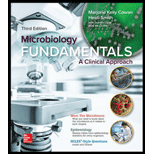
Concept explainers
Introduction:
The acellular organism is defined as the organism that is not made up of the cells, but still has
Answer to Problem 1Q
Correct answer:
Viruses are the acellular microorganisms lacking a nucleus. Therefore, option (d) is correct.
Option (d) is given as “virus”.
Explanation of Solution
Justify the reasons for the correct statement:
Viruses are the acellular entities that are considered as ultramicroscopic infectious particles, viruses are known to infect all the life forms present or earth, from microbes to plants and animals. Viruses have either DNA or RNA as their genetic materials yet they lack cell organelles. Hence, they are named as acellular organisms.
Hence, option (d) is correct.
Justify the reasons for the incorrect statements:
Option (a) is given as “bacterium”.
Bacteria have a nucleoid region instead of a true nucleus, but they are unicellular organisms means they have a single cell. Hence, it is a wrong answer.
Option (b) is given as “helminth”.
The helminths are the multicellular organisms. And each cell has a well-known nucleus. Hence, it is a wrong answer.
Option (c) is given as “protozoan”.
Protozoa belong to domain eukaryotes but are the unicellular microorganisms. So, they contain a nucleus. Hence, it is a wrong answer.
Hence, options (a),(b), and(c) are incorrect.
Hence, viruses are lacking a nucleus, because they do not have cells organelles. Yet,the virushas a nucleic acid, either DNA or RNA.
Want to see more full solutions like this?
Chapter 1 Solutions
Microbiology Fundamentals: A Clinical Approach
- The cells were first seen microscopically by A. Scheiden B. Schwann C. Leeuwenhock D. Robert Hookarrow_forwardThe collection of bacteria, archaea, and eukaryotic microbes that normally inhabit the human body are considered, _____________. a. opportunistic pathogens b. commensals c. microtubules d. obligate intracellular organismsarrow_forwardWhich of these molecules is used in adherens (adhesive) junctions? a. Calnexin b. Cadherin c. Connexin d. Claudinarrow_forward
- This bacterium secretes an exotoxin that binds to nerve cells and causes muscle paralysis. O a. Clostridium botulinum b. Cholera c. Shigella d. Escherichia coli e. Penicilliumarrow_forwardThe presence of what organism is sometimes used as an indicator that there is sewage present in the water? a. Escherichia coli or E. coli b. Pseudomonus c. Amoeba d. protozoaarrow_forwardChoose the combination of answers that most accurately completes the statement.An arrangement in packets of eight cells is described as a . a. micrococcus c. tetrad b. diplococcus d. sarcinaarrow_forward
- A person in England arrives at a medical clinic with a fever and swollen lymph nodes shortly after returning from a visit to New Mexico. For which bacteria should the doctor test the patient? a. Salmonella enterica b. Borrelia burgdorferi c. Clostridium botulinum d. Yersinia pestisarrow_forwardA bacterium has the following characteristics:∙ It adheres to the human intestinal lining using a feature that protects it from phagocytes, bacteriophages, and dehydration∙ It can survive being boiled∙ It contains no plasmids and relatively little peptidoglycanWhich of the following characteristics allows this bacterium to adhere to the intestinal lining? Group of answer choices A. fimbriae B. pili C. an endospore D. a flagellumarrow_forwardYou are treating a patient with antiviral agent against the nucleocapsid, what part of the virus will be destroyed? a. Enveloped b. Cytoplasm c. Capsid and genetic material d. Genetic materialarrow_forward
- What part of an animal USUALLY do not have microbes? A. Teeth B.Genitalia C. Lungs D. Gastrointestinal tractarrow_forwardWhich of these infections involves a life cycle that requires more than one host species other than humans? a. rabies b. cholera c. West Nile fever d. all of the abovearrow_forwardWhich infectious agent is an obligate parasite? a. Mycobacterium tuberculosis b. Corynebacterium diphtheriae c. Mycobacterium leprae d. Clostridium diffi cilearrow_forward
 Human Anatomy & Physiology (11th Edition)BiologyISBN:9780134580999Author:Elaine N. Marieb, Katja N. HoehnPublisher:PEARSON
Human Anatomy & Physiology (11th Edition)BiologyISBN:9780134580999Author:Elaine N. Marieb, Katja N. HoehnPublisher:PEARSON Biology 2eBiologyISBN:9781947172517Author:Matthew Douglas, Jung Choi, Mary Ann ClarkPublisher:OpenStax
Biology 2eBiologyISBN:9781947172517Author:Matthew Douglas, Jung Choi, Mary Ann ClarkPublisher:OpenStax Anatomy & PhysiologyBiologyISBN:9781259398629Author:McKinley, Michael P., O'loughlin, Valerie Dean, Bidle, Theresa StouterPublisher:Mcgraw Hill Education,
Anatomy & PhysiologyBiologyISBN:9781259398629Author:McKinley, Michael P., O'loughlin, Valerie Dean, Bidle, Theresa StouterPublisher:Mcgraw Hill Education, Molecular Biology of the Cell (Sixth Edition)BiologyISBN:9780815344322Author:Bruce Alberts, Alexander D. Johnson, Julian Lewis, David Morgan, Martin Raff, Keith Roberts, Peter WalterPublisher:W. W. Norton & Company
Molecular Biology of the Cell (Sixth Edition)BiologyISBN:9780815344322Author:Bruce Alberts, Alexander D. Johnson, Julian Lewis, David Morgan, Martin Raff, Keith Roberts, Peter WalterPublisher:W. W. Norton & Company Laboratory Manual For Human Anatomy & PhysiologyBiologyISBN:9781260159363Author:Martin, Terry R., Prentice-craver, CynthiaPublisher:McGraw-Hill Publishing Co.
Laboratory Manual For Human Anatomy & PhysiologyBiologyISBN:9781260159363Author:Martin, Terry R., Prentice-craver, CynthiaPublisher:McGraw-Hill Publishing Co. Inquiry Into Life (16th Edition)BiologyISBN:9781260231700Author:Sylvia S. Mader, Michael WindelspechtPublisher:McGraw Hill Education
Inquiry Into Life (16th Edition)BiologyISBN:9781260231700Author:Sylvia S. Mader, Michael WindelspechtPublisher:McGraw Hill Education





